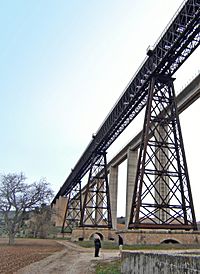Hacho Bridge facts for kids
Quick facts for kids Hacho BridgePuente del Hacho |
|
|---|---|

Hacho Bridge
|
|
| Locale | Guadahortuna, Granada, Spain. |
| Characteristics | |
| Design | Continuous under-deck truss bridge |
| Material | Wrought iron |
| Total length | 624.6 metres (2,049 ft) |
| Width | 4.7 metres (15 ft) |
| Height | 49.85 metres (163.5 ft) |
| Number of spans | 11 |
| History | |
| Designer | Students of Gustav Eiffel |
| Construction begin | 1893 |
| Construction end | 1897 |
| Opened | 22 March 1898 |
The Hacho Bridge (in Spanish, Puente del Hacho) means "Bridge of the Torch." It is an old railway bridge located in Granada, Spain. This bridge was once part of a railway line that went through the Sierra Nevada mountains. It is still the longest iron railway bridge in Spain. The company RENFE helps to maintain it.
Planning the Bridge
In 1889, a railway company in Southern Spain started building a new railway line. This line would go through Guadahortuna in the province of Granada. The company hired Duvel and Butilia to design the bridge. They were students of Gustave Eiffel, a very famous engineer. Eiffel also designed the Eiffel Tower in France.
The perfect spot for the bridge was chosen. It was between the towns of Guadahortuna and Alamedilla. The railway line needed to cross the Guadahortuna River there.
Building the bridge began in 1893. It took four years to finish the work. The Hacho Bridge officially opened on March 22, 1898.
How the Bridge Was Built
The Hacho Bridge is very long, measuring 624.6 metres (2,049 ft). At its highest point, it stands 49.85 metres (163.5 ft) tall. It is a special type of bridge called a continuous under-deck truss bridge. This means its main support structure is underneath the railway track.
The bridge stands on nine strong supports. These supports are made from wrought iron and stone. The main part of the bridge is a long, double beam. This beam is 486 metres (1,594 ft) long and carries the single railway track. It is held up by iron supports that are riveted together. There was also a small walkway next to the track.
Bridge History
The Hacho Bridge was used for over sixty years. It was even used by both sides during the Spanish Civil War. The bridge was very important for the local area. It provided many jobs for people. Hundreds of workers lived near Alamedilla station while the bridge was being built. Many stayed to help maintain it after it opened.
However, in the late 1950s, life became hard in Eastern Andalusia. Many people left the area to find work. At the same time, Spanish railways started using heavier diesel locomotives. These new trains were too heavy for the Hacho Bridge.
About ten years later, the Alamedilla station closed to passengers. Another ten years passed, and Spanish railways decided to sell the Hacho Bridge. They sold it to a scrap dealer from Madrid for 1.5 million pesetas. Other bridges on the Almeria line were also sold.
In November 1978, local people found out the bridge was going to be torn down. They started a campaign to save it. The Mayor of Alamedilla, D. Abelardo Corral, asked the Governor of Granada for help. In a quick meeting, the local government agreed to protect the bridge. They declared the Hacho Bridge a Historical Artistic Monument. This order was given to the scrap company. The Civil Guard rushed to the bridge. They arrived just in time and removed the dynamite that had already been placed to blow up the bridge.
Today, the Hacho Bridge is protected by a national order. It is recognized as a Structure of Cultural Significance.
The Bridge Today
In 1970, a new bridge was built to replace the Hacho Bridge. This new bridge is made of reinforced concrete. It runs right next to the original iron bridge.
See also
 In Spanish: Puente del Hacho para niños
In Spanish: Puente del Hacho para niños

